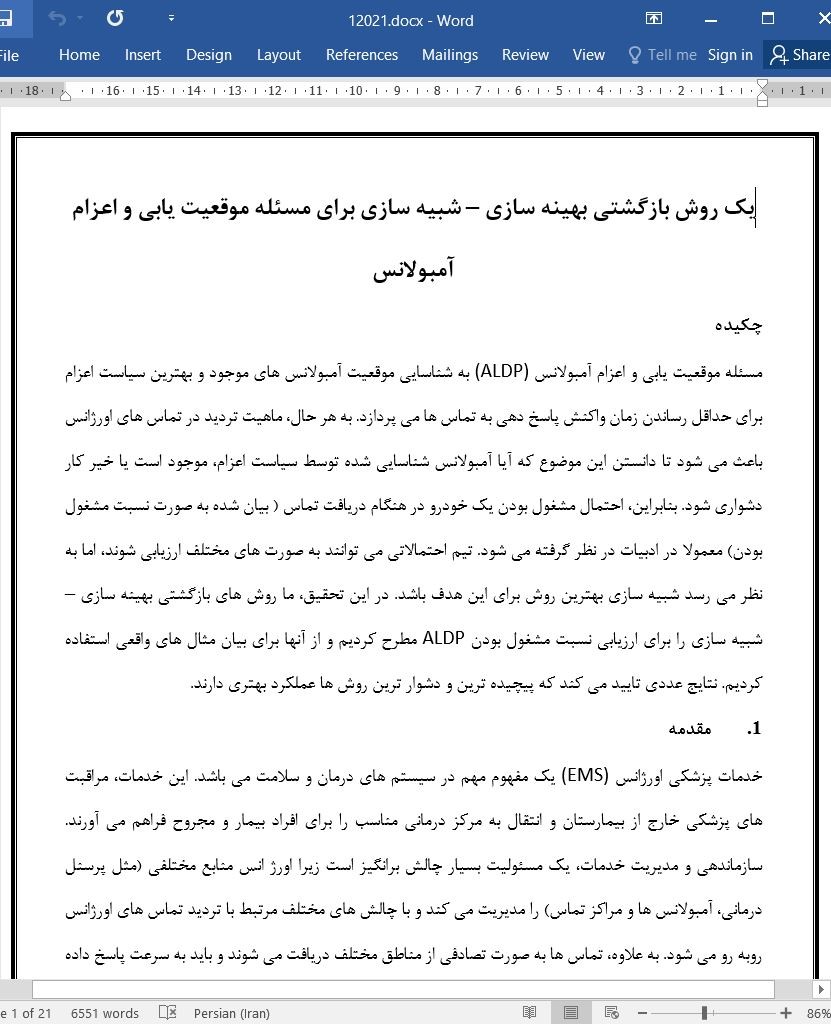
یک روش بازگشتی بهینه سازی – شبیه سازی برای مسئله موقعیت یابی و اعزام آمبولانس
چکیده
مسئله موقعیت یابی و اعزام آمبولانس(ALDP) به شناسایی موقعیت آمبولانس های موجود و بهترین سیاست اعزام برای حداقل رساندن زمان واکنش پاسخ دهی به تماس ها می پردازد. به هر حال، ماهیت تردید در تماس های اورژانس باعث می شود تا دانستن این موضوع که آیا آمبولانس شناسایی شده توسط سیاست اعزام، موجود است یا خیر کار دشواری شود. بنابراین، احتمال مشغول بودن یک خودرو در هنگام دریافت تماس ( بیان شده به صورت نسبت مشغول بودن) معمولا در ادبیات در نظر گرفته می شود. تیم احتمالاتی می توانند به صورت های مختلف ارزیابی شوند، اما به نظر می رسد شبیه سازی بهترین روش برای این هدف باشد. در این تحقیق، ما روش های بازگشتی بهینه سازی – شبیه سازی را برای ارزیابی نسبت مشغول بودن ALDP مطرح کردیم و از آنها برای بیان مثال های واقعی استفاده کردیم. نتایج عددی تایید می کند که پیچیده ترین و دشوار ترین روش ها عملکرد بهتری دارند.
1. مقدمه
خدمات پزشکی اورژانس (EMS) یک مفهوم مهم در سیستم های درمان و سلامت می باشد. این خدمات، مراقبت های پزشکی خارج از بیمارستان و انتقال به مرکز درمانی مناسب را برای افراد بیمار و مجروح فراهم می آورند. سازماندهی و مدیریت خدمات، یک مسئولیت بسیار چالش برانگیز است زیرا اورژ انس منابع مختلفی (مثل پرسنل درمانی، آمبولانس ها و مراکز تماس) را مدیریت می کند و با چالش های مختلف مرتبط با تردید تماس های اورژانس روبه رو می شود. به علاوه، تماس ها به صورت تصادفی از مناطق مختلف دریافت می شوند و باید به سرعت پاسخ داده شوند، هر ثانیه در موقعیت های تهدید کننده زندگی حائز اهمیت می باشد. در این شرایط، سازمان های EMS باید دو سوال مهم را پاسخ دهند: آمبولانس ها در کجا باید قرار بگیرند؟ کدام آمبولانس برای تماس دریافت شده باید اعزام شود؟
Abstract
The Ambulance Location and Dispatching Problem (ALDP) identifies the location of the available ambulances and the best dispatching policy to minimize the response times to answer the calls. However, the uncertain nature of the emergency calls makes it impossible to know in advance if the ambulance identified by the dispatching policy is available or not upon a call arrival. Thus, the probability that a vehicle is busy when a call arises, denoted as busy fraction, is usually considered in the literature. Probabilities can be estimated in several manners, but simulation seems to be well suited for this purpose. In this work, we propose four Recursive Optimization-Simulation Approaches to estimate the ALDP busy fraction, and we apply them to a set of realistic instances. Numerical results confirm that the most sophisticated and computing demanding approaches offer a better performance.
1 INTRODUCTION
Emergency Medical Services (EMSs) are crucial in health care systems. They provide out-of-hospital acute medical care and transportation to the appropriate health center for injured and ill people. Organizing and managing the service is an extremely challenging task, as EMSs manage a large variety of resources (e.g., health care personnel, ambulances and call centers) and face difficult challenges related to the uncertainty of the emergency calls. Indeed, calls randomly arrive from different areas of the served territory and must be served quickly: every second is important in life threatening situations. In this context, EMS organizations must answer two important questions, i.e., where should the ambulances be located? and which ambulance should take care of the arriving call?
چکیده
1. مقدمه
2. مدل های شبیه سازی و بهینه سازی
2.1 فرمولاسیون ALDP
2.2 شبیه ساز
3. روش های مبتنی برROSA
3.1 BRM
3.2 PSSM وQTSSM
4.نتایج
4.1 BRM
4.2 PSSM و QTSSM
4.3 مقایسه
5. E-QTSSM
5.1 نتایج
6.نتیجه گیری ها
منابع
ABSTRACT
1 INTRODUCTION
2 OPTIMIZATION AND SIMULATION MODELS
2.1 ALDP formulation
2.2 Simulator
3 ROSA-BASED APPROACHES
3.1 BRM
3.2 PSSM and QTSSM
4 RESULTS
4.1 BRM
4.2 PSSM and QTSSM
4.3 Comparison
5 E-QTSSM
5.1 Results
6 CONCLUSIONS
REFERENCES
- ترجمه فارسی مقاله با فرمت ورد (word) با قابلیت ویرایش، بدون آرم سایت ای ترجمه
- ترجمه فارسی مقاله با فرمت pdf، بدون آرم سایت ای ترجمه



